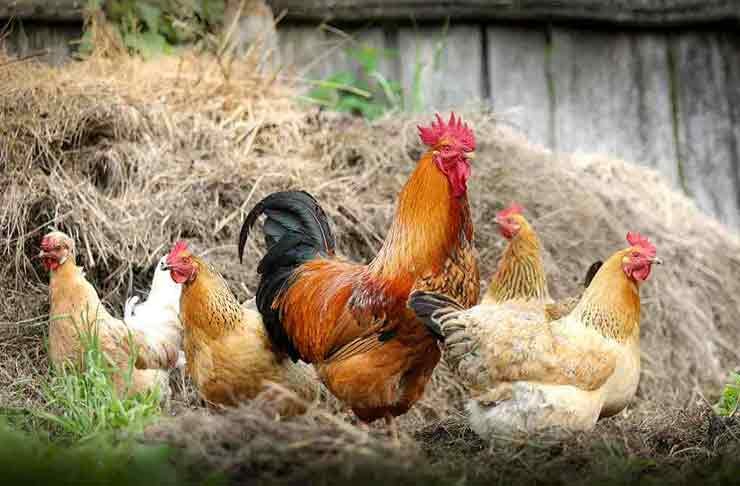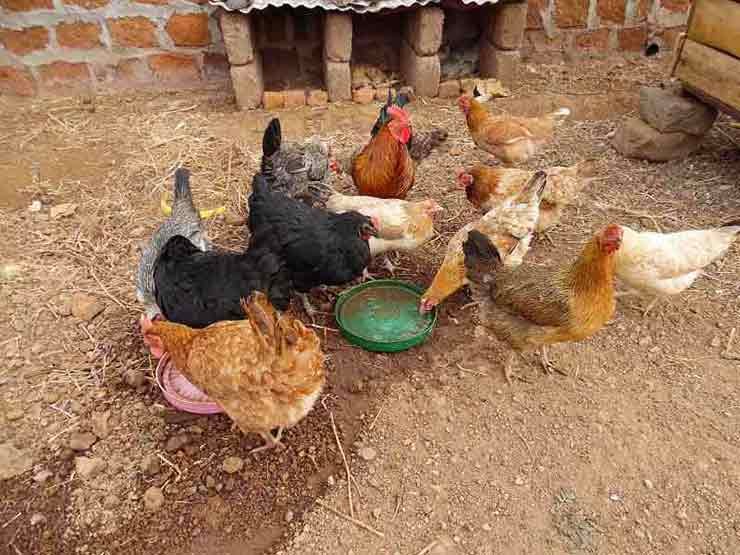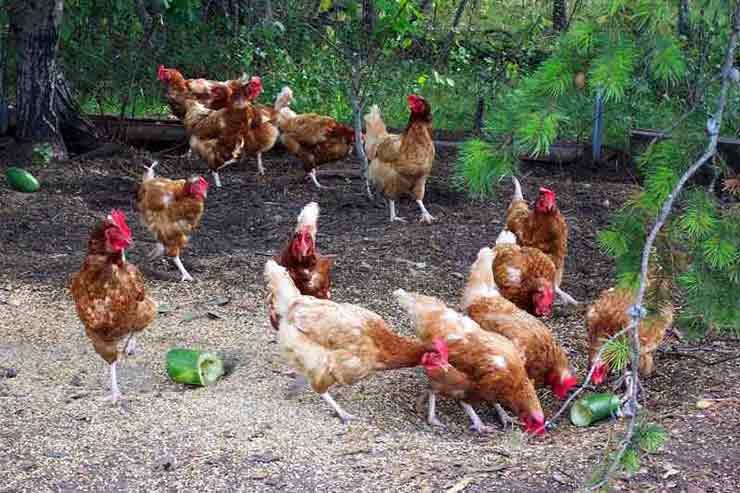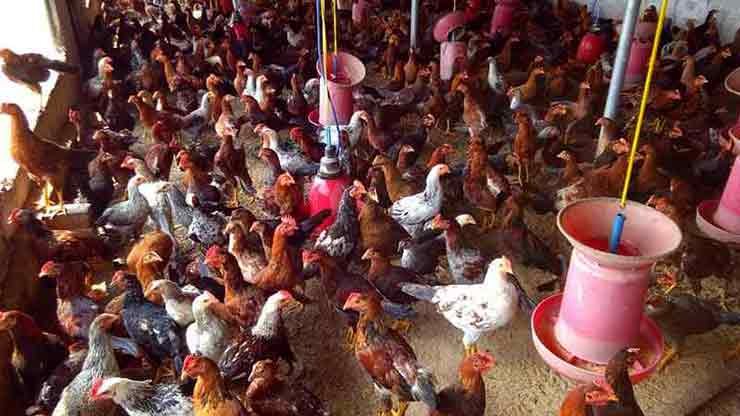Country chicken farming is perhaps one of the easiest poultry management methods since it involves minimum labor. It is something that the family members can join hands in doing. Learn how to start a country chicken farm project in India(desi chicken farming or desi hen farming).
Poultry farming of country chicken or desi hen farming is been in practice since decades in India. Generally, in backyard poultry, local, indigenous birds are reared. Traditionally these birds had a poor egg and meat production capacity compared to commercial broiler and layer farming. But with improved strains there is a considerable improvement in the performance. The biggest scope of country chicken is the low initial investment and high economic returns. The per capita protein consumption has been a subject of concern since quite some time in India. Eggs and poultry meat are the cheapest and most easily available option for this. Although there has been a tremendous growth in poultry farming over the past few decades, rural poultry has not shown much improvement. This is because it has been largely neglected sector. The key lies in focusing on the various aspects of rearing, better management practices and a scientific approach.

Advantages of Country Chicken Farming
The advantages of country chicken farming are as below:
- Low initial investments clubbed with higher economic returns.
- Country chicken farm can be started with just two birds and gradually increased to a flock.
- Owing to the high demand of local chicken, the birds and the egg produced by them can be sold in the local market irrespective of the season.
- Leftover feed, grains and various agricultural by-products can be used as feed for the birds. In other words, the feed cost is negligible.
- Country chicken or ‘desi murgi’ and brown egg variety has a higher demand than other breeds.
- There is no labor cost practically involved since the family members especially children and senior citizens act as ‘laborers’ in maintaining the farm. Hence it is a boost to the family income.
- Since the eggs and poultry birds can be sold almost any time, rural poultry is a form of ‘any time money’.
- If the birds are raised in an organic farm then the quality of the chicken and eggs are much better. This is because the birds are raised in a stress-free environment. In this method the poultry wastes like droppings, extra feeds etc. are directly applied as organic manure and increases crop yield.
Strains of Country Chicken

Generally indigenous or local breeds are poor producers of both eggs and meat. Therefore, improved strains have been developed that are easily adaptable and hardy in nature. They have a good mothering and brooding capacity. Their body conformation is good and is self-propagating. Since they are easily adaptable and more sturdy they are also less likely to develop diseases and infections. They are quick and alert and hence can escape from predators. There are four pure breeds of chicken that are available in India viz. Aseel, Chitagong, Kadaknath and Busra. Some breeds are also developed indigenous to specific location such as:
- Jharsim: A variety specific to Jharkhand.
- Kamrupa: Suitable for free range farming in Assam.
- Pratapdhan: It is a dual colored bird meant for Rajasthan.
Other ‘desi murgi’ breeds that have been developed are CARI Nirbheek, CARI Shyama, Hitcari and Upcari. These breeds were developed at the Cantral Avian Research Institute (CARI), Izzatnagar.
Varieties like Gramapriya, Vanaraja, Krishna-J, Girirani, Giriraja, etc. can be reared almost anywhere in India. Gramapriya and Vanaraja produce 200-230 eggs annually with the individual egg weight varying between 55 to 60 grams. They start laying eggs at the age of 200 days. The age of first lay varies with the feed, nutrition and other management criterion.
Housing Facilities for Country Chicken Farm
Since country chicken is of the sturdier and adaptable type, they do not need elaborate housing preparations unlike other breeds. The houses must protect the birds from harsh sunshine, rain, wind and cold stress. It should also protect them from frost during winters. In case of free range rearing system the birds are let loose to forage during day and kept in pens during night time. In order to avoid direct sunlight and encourage maximum air circulation the houses must be built in the north-south direction and not in the east-west direction. Inexpensive, locally available housing materials like bamboo, wood, thatch, grass, etc. are used for building the houses. The floor is at an elevation to avoid water accumulation or flood-like conditions. It must be free of rat trouble or water cracks, must be portable to enable shifting the position of the houses if need be and they must facilitate easy cleaning. There must also be a bulb fitted at the ceiling to keep the chicks warm and provide light.
Farm Feed

As compared to other forms of rearing feed expense in country chicken is at a minimum since the birds are let to scavenge out in the open. Their daily nutrient requirements of proteins, vitamins, minerals and energy are met through worms, insects, weeds, household waste, crop residue and leftover grains that they collect and eat during scavenging. Rice bran, broken rice, ground nut straw, etc. can be given as an additional supplement. They fed twice a day. The feed is not stored for more than a month during rainy season since the feed would develop fungal contamination. For better performance, an extra ration supply of 30-60 grams per day can be supplied to the birds. The feed is formulated with wheat bran, fish meal, maize, rice polish, shell grit or lime stone for fulfilling the vitamin, mineral and salt requirements. An ideal poultry feed must meet the following requirements:
| Stage of Growth | Protein | Energy |
|---|---|---|
| Starter | 20% | 2800 Kcal/Kg |
| Grower | 16% | 2600 Kcal/Kg |
| Laying | 18% | 2650 Kcal/Kg |
During the growth stage the birds are fed with the standard starter feed for chicks available in the market. In addition to the feed collected through scavenging, the birds are also fed with azolla, drumstick leaves, waste grains, mulberry leaves, etc. during the growth stage. After 120 days the average body weight must be 1.3 to 2.4 Kg. In addition, they must be fed in small quantities from time to time during the initial few weeks this helps in stimulating the feeding habit. In addition it helps growth of skeletal feathers and develop a good immune system.
Chick Brooding
Brooding is described as the ‘art’ of raising chicks right from the day they hatch. A newly hatched chick takes about two weeks to develop its own homeostasis and thermoregulatory system. In other words, they are unable to maintain their body temperature during the first few days of their life. Hence special provision must be made for maintaining the body temperature. This process is called brooding. Brooding is of two types-
- Natural Brooding: In natural brooding, indigenous broody hens are used as sitters. The hen is provided with all the necessary nesting materials including food and water. Eggs belonging to improved variety are used for incubation. Once the eggs hatch, the chicks are left with the mother for scavenging. Special provisions are made for the chick and the mother for the nights. A Broody hen can take care of 12-15 chicks at a time.
- Artificial Brooding: No broody hen is used in this case. Instead there is a provision for supplying artificial heat. There are specially designed ‘bukharies’ in which wood, charcoal, kerosene, saw-dust, etc. is used as a heat source. The temperature is maintained at 95⁰ F in first week. In the following weeks, it is reduced by 5⁰F till the 6th week. On an average a heat of up to 2 watts per chick is needed in the brooding stage.
Wellness Management in ‘Desi Hen Farming’
Once the chicks are brought to the farm it is the farmers’ responsibility to ensure its wellness and good health. There are a few points that must be considered precisely for this purpose.
Brooding and Feeding Facilities
The chicks must be placed in the brooder and the feeder must be replenished more at least twice a day and more if need be. They must be stimulated to drink water. For this purpose cups are placed in the initial period. In case of artificial brooders their temperature must be checked regularly. Too high a temperature would result the chicks in moving away from the bukharies while too low a temperature means the chicks would huddle together.
Floor Space for Country Chicken Farming
Chicks brooding in deep litter need about 280 cm² of floor space per chick. From the 6th week approximately one square foot of floor space must be provided. Overcrowding in the brooding stage can cause stress thereby leading to infections and mortality. The feed conversion ratio and growth must be proportional to the floor space available for the chicks.

Light Management
The idea behind providing light in brooders is to increase the feed consumption and thus maximize the growth in a very short period of time. For the first six weeks there must be continuous light for the up to 48 hours. During the growth stage 10-12 light hours is needed. While providing light provisions, there must also be a chick guard to prevent the chicks from coming directly in contact with the heat bulb. It is normally made of cardboard.
Drinking Facilities
For a day old chicks, they must be provided clean drinking water in troughs. The amount of water must not be more than 2 cm high. For the first three days, irrespective of the type of brooding bell-shaped water drinkers are recommended. The drinkers must be placed near the hovers.
Ventilation and Relative Humidity
Accumulation of carbon dioxide and ammonia clubbed with oxygen depletion is one of the major causes of mortality at the brooding stage. If the brooders are fit with airtight curtains it would lead to a lot of gas accumulation and suffocation of the chicks. Hence a head space of 3.5 inch must be left between the ceiling and the curtain to ensure air circulation.
Similarly a relative humidity of 65% must be maintained. Care must be taken to prevent the relative humidity from dropping below 50% as it would result in dehydration among the chicks. Spraying disinfected water is one way of maintaining humidity at the optimum level.
Beak Trimming
Trimming of beaks may seem absurd but it is an important step to prevent feed wastage and cannibalism. It is done in the 3rd week and about one third of the beak is trimmed. Cauterization of the beak using hot iron is the most commonly used methods of beak trimming. It destroys the beak growth tissues and also arrests beak growth. During cauterization care should be taken to not burn the tongue.
Litter Management
This is a very important step in controlling the diseases among flock. The litter must be kept dry and stirred regularly. Stirring helps in regulating the temperature, humidity levels and ventilation.
Disease management for desi chicken
Country chicken is very hardy compared to factory farmed broiler or layer chicken. But there are some aspects which must be followed carefully to reduce the mortality.
The litter must be kept dry and stirred regularly to regulate the temperature, humidity levels and ventilation.
Accumulation of carbon dioxide and ammonia clubbed with oxygen depletion is one of the major causes of mortality at the brooding stage due to airtight fittings of curtains. It causes a lot of gas accumulation and suffocation of the chicks. Hence a head space of 3.5 inch must be left between the ceiling and the curtain to ensure air circulation.
Similarly a relative humidity of 65% must be maintained. Care must be taken to prevent the relative humidity from dropping below 50% as it would result in dehydration among the chicks. Spraying disinfected water is one way of maintaining humidity at the optimum level.
Marketing of Country Chicken
Marketing country chicken is very simple since local, indigenous chicken variety is always in demand in the markets. They can be supplied in shops or the farms can have a tie-up with hotels for supplying country chicken on a regular basis. Country chicken farming(desi chicken farmnig) is an alternative source of income in integrated farming system.
Country Chicken Farm Project Report for Bank Loan
You’ll need a project report to apply for bank loan. We have published two customizable Country Chicken Farming Project Report PDF, one for dual purpose (chicken meat and eggs) and another for purely meat purpose. With these project reports will be able to calculate project cost and profit and also apply for bank loan.
References
- http://www.krishisewa.com/articles/livestock/410-backyard-poultry-farming.html
- http://www.agritech.tnau.ac.in/expert_system/poultry/brooding%20of%20chicks.html
- http://agritech.tnau.ac.in/agriculture/agri_majorareas_smmf02.html
- http://dahd.nic.in/sites/default/files/Excerpts%20of%20Poultry%20Farmn%20Manual-ilovepdf-compressed.pdf
- http://vikaspedia.in/agriculture/poultry/backyard-poultry/breeds-availability

I want to start country chicken hen farming plz help in supplying chicks
Can we book in this website?
Right now we do not provide online booking of products.
Hi Team,
My Self Madhu, I am from Hyderabad Outscuts,
I am planning to start this bussiness as early as possible,
So can you breif me that,
1. How much investment for this,
2. From where can I buy cheeks,
3. How much place required for this,
So kindly give me your suggestions on this,
Other wise gave me your mobile number I will call you.
Hello! Country chicken farming is very profitable with much less investment. Please download our project report for complete details on investment and profit-loss details.
We have started Pilot project of 250 chicken which has RIR, Giriraja and Kadaknath. Our plan is to extend the next batch to 1000 chicken after watching results of current batch.
Hi
I have 650 birds (500 hens+150 males) (6 months age) of DP-Cross breed. All birds are healthy and infection free. All necessary vaccines are given time to time.
I am aiming for egg production but till now the results are not so good. I am getting hardly 30-35 eggs per day. Feeding is ‘Layer mesh’ 120-140gm/bird/day. Egg quality good. weight of an egg is around 35-40gms.
How can improve number of egg production?
first You will correct the breeding selection, meet purpose is suitable acil and acil cross. and othervise egg production you now go to vanaraja and giriraja . that only gave a high production of eggs per yearly 180 to 250eggs … Thanking You
Very helpful. Thank you. Can you please explain what’s the best local breed available in India for egg production and what’s best for meat?
Are you going for commercial poultry farming? If yes then you should consult with experts before investing. If you’re going for noncommercial hobby farming then refer these articles- Poultry farming in India, Broiler farming guide and Poultry layer farming guide.
I want people project report on growing country chicken.
Hello,
My self Mosin khan I’m from Nagpur Maharashtra
I’m planing to start business desi bird & desi eggs plz let me know how to start the project n contact u thank u so much.
Thank you for your interest in Desi chicken farming. You may download project report for complete details in country chicken farming project.
सर मैं कोटपूतली जिला जयपुर राजस्थान का निवासी हूं मैं देसी मुर्गी फार्म करने की योजना बना रहा हूं आप इसमें मेरी क्या हेल्प कर सकते हैं
I want to start a Desi poultry farm. Plz guide me.
Are you willing to buy professional consultancy service for poultry farming?
We have started poultry project with 200 chicks, how to maintain poultry batches?
Dear Sir,
Initially I wanted to buy 200 RIR chicks and bring it up in a folk manner,
My land is approximate 60 acre and this is ideal for mix farming(cattle,poultry and fish), where I can buy RIR chicks first can you help me sir?
I’m starting country chicken farming suggest me how much land it will be needed for and what material it should be needed for construct the shed for 2000 chicks and also help me for marketing
We shall contact you once we get started the primary consultancy service.
Or give contact no. of any expert so I can ask all the queries about this
We shall contact you once we get started the primary consultancy service.
Dear sir
we want to make desi murgi farm 200nos for egg production not chicken
please guide which type home require
howmuch expenditure come in the year
Dear sir
we want to make desi murgi farm 200nos for egg production not chicken
please guide which type home require
howmuch expenditure come in the year
What is the your per piece price for Hen?
Right now we do not sell day-old chicks.
I want to start a desi murgi farm in a very small scale.
Please suggest and help.
Hai, i want to start country poultry farm in Andhra pradesh (egg production) what kind of breed do you suggest
Project report
Good morning sir.
I m from india goa. Vinayak korgaonkar
I want to start india village desi chicken farm business. Give me suggestion and tips…
I start business in small scale..
Respected sir. I. Want to start Desi murgi small form so I want get which breed shal l you advise . Thanking you
Please help how start
Counter startup poultry form what is the procedure in the what is requirement as I have my own land and have good market and have good contact to hotel to supply in hotel